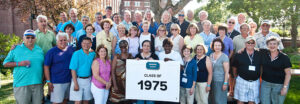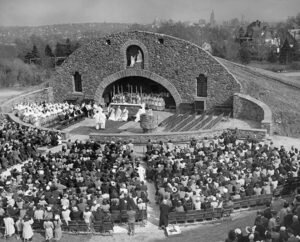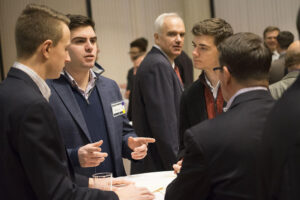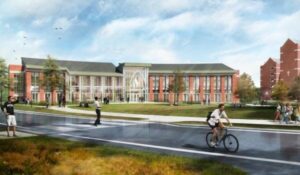Tag: Marla Gagne ’18
Friar Flashback: Looking Back With Alumni
by The Cowl Editor on February 10, 2017
News

By Marla Gagne
News Co-Editor
Throughout the years, thousands of alumni have graduated from Providence College and witnessed the campus transform. Some of those alumni dedicated to education and the mission of PC have returned to campus to continue to guide new generations of students. As PC charges into a new era, here are some of the voices from its past.
In 1971, Providence College was a different campus. Every student was male, mass was held at Guzman Chapel, about 75 percent of students commuted, and the notorious Development of Western Civilization program was just being created.
“It was a schizophrenic class,” says Dr. Raymond Sickinger ’71, chairperson and professor of the history department. As he looks back on his time at PC, he recalls that it was a great time of change, both on campus and across the country.
Dr. Sickinger grew up locally and attended La Salle Academy with now Rhode Island Senator, Jack Reed. The dream of going to college was not always financially possible, but became a reality after he graduated as valedictorian, securing a full ride to PC.
The early 1970s was the “era of the coffeehouses.” Dr. Sickinger played coffeehouses in Rhode Island and New York and was even roped in by Fr. Paul Philibert, O.P. ’58, to play guitar during mass. Dr. Sickinger said it was a “subtle way that kept me close to the Catholic Church,” carrying on the Dominican tradition of really looking out for the individual student. Dr. Sickinger also recalls sitting on the steps of Aquinas Hall as the whole school was shut down to allow students to protest the Vietnam War.
He would later return to PC after graduating from the University of Notre Dame. Upon his return, he saw a co-ed campus and DWC coming to life, a program he had input in as a student.
Looking back, Dr. Sickinger confidently believes that if “[PC] had not gone co-ed, it probably wouldn’t exist today.” This “right decision at the right time” allowed women to bring a new perspective to each class, especially as historians began to recognize women’s influence in history.
As for DWC, he believes DWC has “made [him] a better teacher and historian.” Civ has allowed students and professors to see the overlap of different disciplines, focusing not just on history but literature, philosophy, and theology as well. Students also begin to understand the strengths and weaknesses of the Western culture. Only by “understanding our own culture” can students “understand other cultures.”
Dr. Sickinger continues to watch the school transform and notes how alumni are “absolutely floored” when they return. He believes the College will continue to move in the right direction as long as they “don’t lose the liberal arts foundation” that has allowed PC to be a unique and thriving college
Before Wanda Ingram, senior associate dean of undergraduate studies and freshman class dean, came to PC, it was still all men and majority white. A self-labeled military brat, Ingram was located at a Newport base and looking at local colleges like Worchester and Brown University. But after some persuasion from a PC alum and high school guidance counselor, she attended PC.
Ingram recalls often standing out wherever she went, being part of the first class of women and a woman of color. She recalls in that first year “there was no mixing of genders at all.” Female students were located in Aquinas, also the home to DWC, and any males, including fathers, could not move past the lobby.
Racism was something that Ingram faced at the time and often just “dealt with it.” With only about 12 women of color on campus, she was constantly being watched. She recalls experiences where some students, professors, and Friars would tell her she did not belong here and assumed was on scholarship.
A great source of her support and close relationship came from fellow students of color and older African American men, her so-called “older brothers.” They formed a tight community and would have each others’ backs through the ups and downs of school.
Looking at PC today, Ingram sees the beautiful transformation of the campus and the continued success of students and alumni. In reaction to recent protests on campus and across the country, Ingram says she is “so sad to be seeing the same things all over again,” but she has great hope that everyone will continue to do the work that needs to be done with time and patience.
For Dr. John Breen ’81, the chairperson and professor of the chemistry department, coming to PC was not something that happened by chance—it was in the family. His father, John J. Breen ’47, taught in the business department for 46 years. With free tuition, Dr. Breen took advantage of the great deal and attended PC as a commuter student.
Dr. Breen found a home with the PC Men’s Track and Cross-Country Team, finding them to be his main social circle on campus. He also experienced DWC in its original form when it was five days a week for 50 minutes and four semesters with seminars thrown in throughout the semester.
Dr. Breen recalls, “It was hard to get an A, but with a reasonable effort B and B+ grades were achievable.” He kindly remembers two of his favorite professors, Professor Delesanta and Professor Grace, but also the tough freshman exams. Over 200 students were in Harkin’s auditorium where they faced a 23 page narrative with 164 fill in the blanks. People just started to give up and leave after three hours. But he believes “Civ has come a long way from that and is now a course where connections between ideas, literaryworks, and historical events are made and students are asked to write and re-write papers demonstrating that they recognize the importance of these connections.”
After working in Indiana for 10 years, Dr. Breen’s wife was tired of living out west and wanted to move back to New England. After some job searching, he discovered PC had a spot for a chemist open. “I can say I am very happy we made the move and I have never looked back.”
Every new academic year, Dr. Breen is excited to be back at PC to see a new class of students. “I like the ‘spring like’ feel I get every fall when the campus comes alive again with students and the new freshman class arrives.” He also is excited to continue to “learn new things about chemistry, matter, etc. and I get to do that as I continually change my upper level courses.”
As Dr. Breen thinks back on his own experience and PC today, he wants the College to be a “safe and supportive environment” and a place that everyone can “look fondly back on their time at PC as being central to their growth into adulthood. “
Friar Flashback: War Memorial Grotto
by The Cowl Editor on February 3, 2017
News

By Marla Gagne
News Co-Editor
In 1948, Fr. Charles H. McKenna, O.P., a local Rhode Islander and Providence College alumnus, set out to build a memorial that would not only honor the dead, but also be a place of peace and comfort for the living— and he did just that.
St. Dominic Chapel is an integral part of daily life for PC students; where they can go to mass, meet with Friars, and hang out with students. But before the Chapel existed, the center of student life and religion was the grotto.
Adjacent to the chapel is a piece of the current War Memorial Grotto, originally created in 1948 to honor the fallen Providence College men during World War II. Three thousand, three hundred men, both alumni and current students, enlisted in the armed forces between 1941-1945; 69 of those men never returned home.
Fr. McKenna, a PC alumus and Dominican from Pawtucket, decided that these men should never be forgotten. Serving as the chaplain of the student body in 1938, he headed a campaign to build the grotto.
According to the Phillips Memorial Library records, McKenna championed a vision that “encompassed the idea that this would be not just a memorial, but also a place where future generations of PC students could find a place of quiet refuge from their hectic daily lives.” Still the center of daily life at PC, McKenna’s dream holds true 79 years later.
From its inception, the memorial has been a community effort. PC families, alumni, students, and fellow Rhode Islanders fundraised the majority of the money to build the memorial. One of the biggest fundraising events was a Penny Sale at the Rhode Island Atrium. The 1949 event drew in over 15,000 people, a record crowd, and was a great success, raising $41,000.
On-campus clubs also donated money from festivals and on-campus events. Students even took the lead when it came to the actual building of the memorial, often volunteering their time to help with construction. The students’ help and donated materials from the community greatly brought down construction costs.
On a windy day in May, less than a year after construction started, religious and government figures joined the ranks of 10,000 people to see the dedication. The College’s President, Father Robert J. Slavin, O.P., presided over the ceremony, while Father Harold C. Boyd, O.P., gave the homily.
His sermon focused on “The parallel of the martyrdom of motherhood of the heroes who gave their life for the preservation of freedom and the ideas of Christianity and the significance of the sublime example of the Mother of Christ.”
The memorial adorned two Italian carved Carrara marble statues at the center, showcasing St. Dominic receiving the rosary from Mary. There was a custom Wurlitzer organ, bronze altar appointments, and black granite Honor Roll panels that hung on both sides of the altar and read the names of the fallen students.
While the grotto would continue to serve as a somber reminder of the young lost, it also brought new life to the College. Students sunbathed on what was known as the “Beach Grotto,” played baseball or frisbee, or just brought blankets to hang out.
Old photos show crowds of students showing up in their bathing suits to enjoy good weather, live music, and parties.
The spot also held Sunday mass and evening mass, Diocesan Retreats, parents’ night, and the graduating class’ baccalaureate mass, among other services.
By the 1980s, the use of the grotto began to show. The campus saw the memorial’s “slow deterioration,” while also facing the problem that the “campus chapel facilities were clearly inadequate to meet the spiritual needs of a growing student body.”
The Ad Hoc Committee for the War Memorial Grotto under the College’s president Fr. John F. Cunningham, O.P., decided to keep “the key components of the Grotto while constructing a new campus chapel.”
The 117 foot chapel was inspired by Byzantine and Italian structures and can hold 600 people.
Many structures were made in Italy, 45 stained glassed windows adorned the walls, and the relics of saints, such as St. Catherine of Siena, St. Thomas Aquinas, St. Dominic, St. Agnes, and Blessed Melchior are entombed in the chapel’s altar.
By 2001, the chapel and new memorial were completed. Adjacent to the chapel lies the new memorial, one third of the original size, and still possesses the same stonework, statuary, and memorial plaques.
The grotto, although not the massive structure it once was, still continues to hold the memory of fallen students and is an everyday part of current PC life.
By 2001, the chapel and new memorial were completed. Adjacent to the chapel lies the new memorial, one third of the original size, and still possesses the same stonework, statuary, and memorial plaques.
The grotto, although not the massive structure it once was, continues to hold the memory of fallen students and be an everyday part of current PC life.
Alumni Networking: Make Mistakes and Connections
by The Cowl Editor on January 27, 2017
News

by Marla Gagne ’18
News Co-Editor
For many students, December and January are a time of stress (finals week), celebration (the holidays are finally here), and New Year’s resolutions (and breaking them). For Providence College’s Center for Career Education and Professional Development, it is the perfect time for networking.
Over break, many students took advantage of the alumni events happening in various states, connecting past and present Friars. The Career Center teamed up with the Office of Institutional Advancement to host two networking nights in Hartford, Connecticut ,and New York, New York, while also on hosting game watches for alumni and current students in New Jersey and Los Angeles. Stacey Moulton, associate director of the Career Center, said alumni in the Hartford area were very interested in connecting with students and reached out to the school to plan the event.
The smaller gathering allowed “students to talk with everyone” on a more intimate level and move outside of their own industry. The New York night featured an alumni panel that allowed students to see alumni at all stages of their careers.
The College also hosted an easy-access networking night that took place Jan. 24 on campus. All majors and years were welcome to stop by the two-hour event, mingling with alumni and hearing from keynote speaker Natalie Leonard ’93, who has been involved in human resources for 20 years and taught HR classes at Johnson &Wales University.
One of the new features of PC’s networking night was a color-coded system to help students identify which alumni could help with their interests and possible career paths. Moulton emphasized that many people, like herself, have made career changes over the years and this allows students to be aware that someone in a marketing background may also have experience in finance or was an English major in school.
Each alum wore a badge that identified any of the industries they have worked in, while students wore similar badges that identified what industries they are interested in pursuing. And unlike at career fairs, this was not a night to stress about getting jobs or internships; it was a time to explore.
Networking nights allow students to “discover careers that they never knew existed or even just advice,” said Moulton. She also encouraged students to find out how alumni used their experiences from things like DWC or acting on the Board of Programmers to their advantage.
Moulton emphasized most importantly that this was a time for students to “make mistakes.” Visiting alumni want to help students, and many were in similar spots not too long ago. Students do not need a perfect elevator pitch or a stunning resume. They just need an open mind.
Brittany McHale, associate director of alumni relations, said “I often see that the PC connection takes a bit of stress off the student because they know they already have something in common with the person they are meeting, this might not always be the case when meeting a recruiter or unknown employer. Students can also hear firsthand accounts of how a former PC student went from campus to career.”
One concern of many non-business majors is a lack of resources for them at career events. Moulton said the Career Center recognizes that students feel this way and are working to provide more resources. On March 26, the Career Center will be hosting its annual spring Career Expo where they hope to provide more diverse resources. It will “definitely not be a business fair,” said Moulton.
The Career Center has been meeting with various majors to incorporate more resources for students. Staff members have talked with the biology department to discuss which companies or research facilities they should contact for the expo, while also reaching out to the Feinstein Institute and Campus Ministry to look at more service and volunteer options.
Along with job and internship opportunities, students will also be able to look into graduate schools, gap year programs, and just talk to alumni that may have advice about moving to a new area after graduation or what classes to take at PC.
For non-business majors that might question the value of networking nights, Moulton encourages them to attend as many events as possible. Although they may not find someone with their dream career, they can still receive advice that Moulton believes, “is transferable to all industries;” students can even just learn about the “transition from PC to the working world.”
Students can continue working on their networking skills at the Etiquette Dinner on Feb. 26. More information about the career Expo and new resources will be coming soon.
Open for Business
by The Cowl Editor on January 19, 2017
News

by Marla Gagne
News Editor
After four weeks on vacation, students returned to Providence College preparing for a new semester, fighting the long bookstore lines, and reuniting with friends. But a new buzz also filled the air as students, faculty, and staff explored PC’s newest campus addition-The Arthur F. and Patricia Ryan Center for Business Studies. The PC School of Business (PCSB), established in 2007, now has a new home in the Ryan Center.
The 64,000 square foot building that connects a new addition to the remains of a former residence hall, Dore Hall, will serve students in undergraduate accountancy, finance, marketing, and management programs along with the graduate MBA program.
Construction began in 2015 with the demolition of Dore Hall and continues into 2017 as construction workers put finishing touches on the building. The Ryan Center, which cost $30 million to build, is named after alumnus Arthur Ryan ’63 ’90Hon and his wife, Patricia, who donated five million dollars to the Center. The building is designed with technologically advanced classrooms, new study spaces, conference rooms, computer labs, faculty offices, and a café.
Students walking into the Ryan Center Tuesday morning for their first day of classes were greeted by a glass atrium and an open space lobby filled with couches, tables, and chairs for students to socialize, study, and relax. Natural light flooded the room, a result of the atrium glass and the halo skylights installed in the ceiling.
New classrooms are equipped with advanced technology, large conference tables spread throughout the room, and white boards covering multiple walls. Students may also use collaboration rooms, which allow small study groups to reserve rooms and work together in a quiet place equipped with white boards and a television.
Dr. Daniel Horne, associate dean of the PCSB, emphasized how this facility allows professors to teach in a new way and “move towards active learning.” Many current classrooms are set up lecture style, having the professor stand at the front of the room and talk to students. The new classrooms, however, are made for collaboration and a two way street for knowledge.
Professors can more openly walk around the room, teach and write on the board from multiple angles, and transfer images on student computers to the larger screen. Dr. Horne believes this collaborative learning will allow students and professors to communicate and learn more effectively.
The Center also includes a 125 seat lecture hall, computer labs, and the Finance Lab. The Lab will house the Bloomberg terminals, allowing student investors to track the markets in real time.
Despite the building hosting the PCSB, all students are encouraged to use the building resources. Madeline Parmenter, director of media relations, said all majors are welcomed as study rooms are a “space for everybody,” just as the Ruane Center for the Humanities welcomes all. The building will be open from 7 a.m. to 12 a.m. Sunday through Thursday and will extend its hours to 2 a.m. on Friday and Saturday.
One of the biggest features of the Center for students and staff is the new café. The new food spot, Eaton Street Café, boasts a deli, grill, bakery goods, and Starbucks coffee. Sandella’s and Friar Buyer, once located in Davis Hall, are now located in the new café and still allow students to use Friar Bucks.
Students can go seven days a week and also experience the new option of a late night take out window. The walk-up station, open Thursday, Friday, and Saturdays from 12-2 a.m., offers classic burgers, chicken patties, cheese quesadillas, tater tots, and more
Students and faculty from all disciplines have continually visited the Center, checking out the new study spaces and, more commonly, the coffee options. This greater connection with upper campus was a major goal of the College, which aimed to connect upper and lower campus and fuse business studies with a liberal arts education.
In the groundbreaking of the Ryan Center in October 2015, president of PC, Fr. Brian Shanley, O.P., said, “You’re going to get a great business education from a terrific faculty, but you’re also going to get a liberal arts education. You’re going to have both sides—business expertise, and the kind of mind and heart that comes from the liberal arts.”
On Jan. 24, an informal opening for the Center will be hosted at the Ryan Center, while an official dedication is planned for Saturday, April 29. The Ryan Center not only allows students to celebrate 100 years of tradition and history, but to continue to make it.
